Audi RS7 Sportback vs Porsche Panamera Turbo, what’s better?
The new Porsche Panamera Turbo 550 hp 2,071 kg and the Audi RS7 faces Sportback Performance with 2,042 kg and 605 hp. What will be the winner in this duel sporting heavyweights?

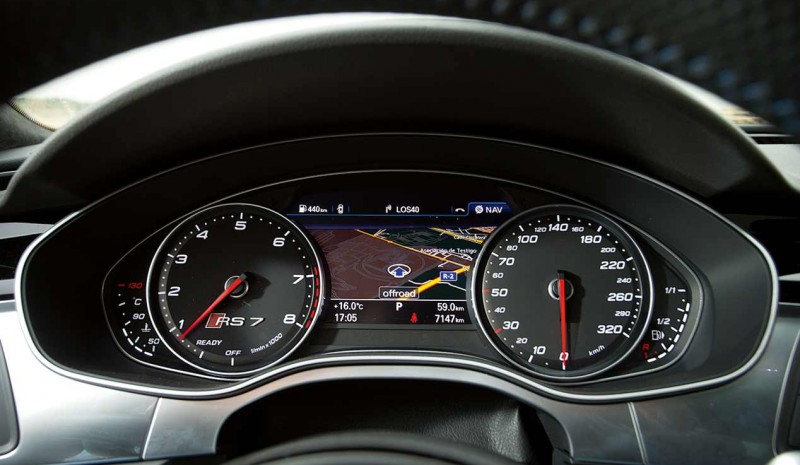
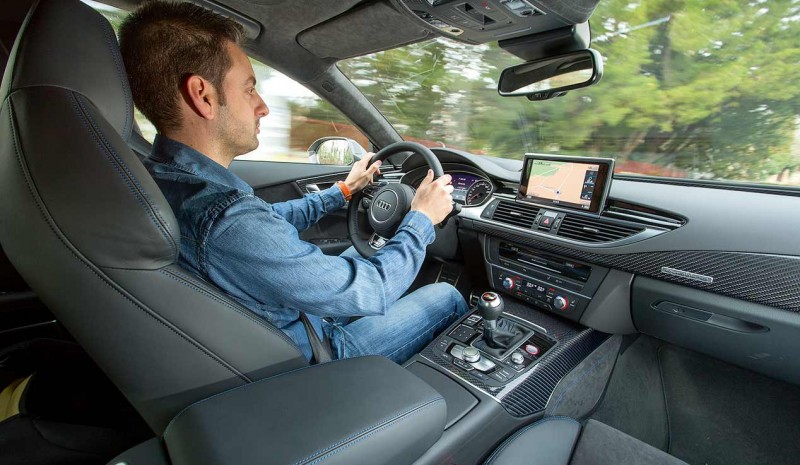
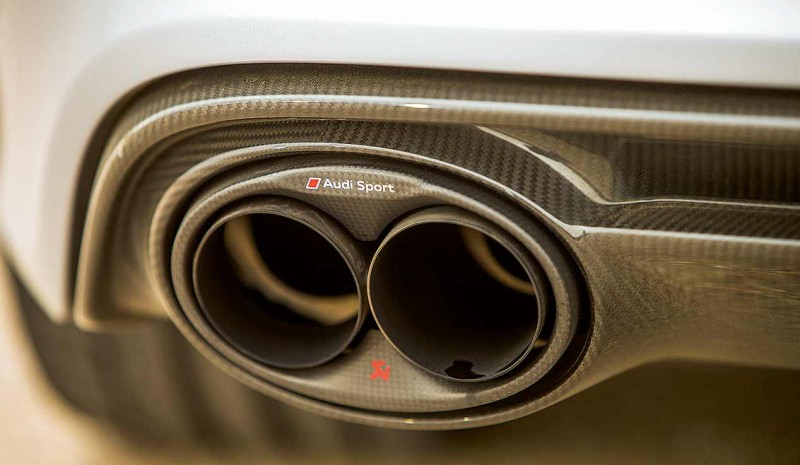
Imagine you are before a boxing heavyweight: On one side of the ring, the "roockie" Porsche Panamera Turbo of 2,071 kg, with 550 hp and a devastating “blow” with his rear direction; on the other hand, 2,042 kg he "veteran" Audi RS7 Sportback Performance who defends his title new exhaust Akrapovic and its 605 CV.
I think I had never done such a matched comparison. It was a fight to the end that has been decided on points, because no one has left KO anyone. And that the Porsche Panamera came ready to throw to the canvas oldest Audi RS7, but recognize that defended very well. Ingostadt model had very reliable weapons, as they are a more power in the Performance version and slightly less weight. This has made it possible within benefits the two cars have been the hundredth. He Audi is the winner in this duel direct hits which only takes into account the motor in the first meters, power and speed of change. But, as I said earlier, that victory is by hundredths, as shows that the difference in the 0 to 100 km / h is 0.01 sec. Y leaving kilometer from standstill, the difference is 0.13 seconds.
| BENEFITS | Audi RS7 Sportback Performance | Porsche Panamera Turbo |
| Acel. 0-100 km / h | 3.42 s | 3.43 s |
| Acel. 0-1000 meters | 20.94 s | 21.07 s |
| Overtaking 80-120 km / h in D | 2,12 s | 2,19 s |
| Loudness 120 km / h | 67.4 dBA | 68.5 dBA |
| Braking from 140 km / h | 70.3 m | 65.5 m |
| Weight scale | 2,042 kg | 2,071 kg |
The recoveries they should have been a little decanted to the side of the ring Audi, because it has a change with a little shorter developments. However, here the balance is even more equalized and even beat some records Porsche. Maybe because debut the new dual clutch gearbox 8-speed. The truth is that it is a mechanical element I expected more in this brand new Panamera. Although the new sedan Stuttgart has impressed me so much from the first moment, perhaps because I expected more from it.
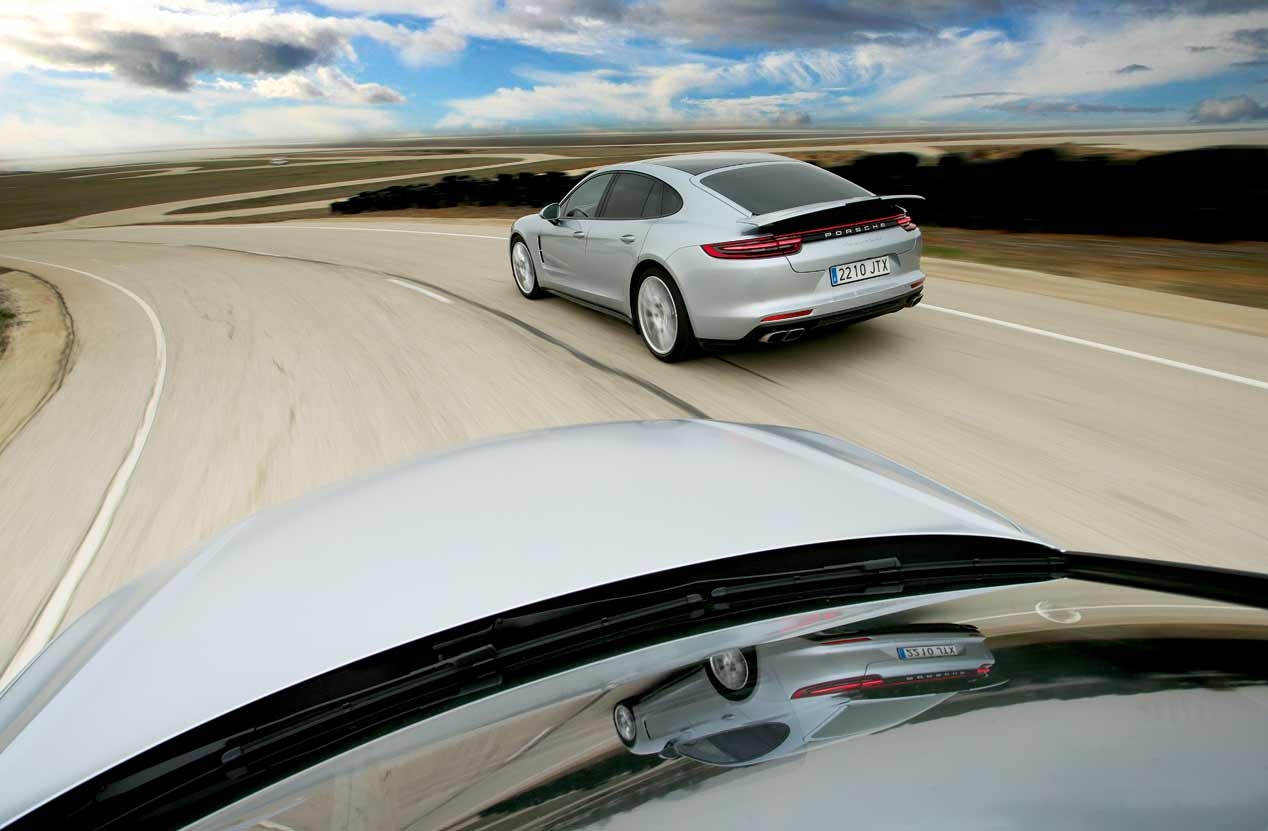 Porsche Panamera Turbo and Audi RS7 Sportback, details and more details
Porsche Panamera Turbo and Audi RS7 Sportback, details and more details
First things first. When you climb for the first time This generation of the Porsche Panamera, all other cars are going to seem like much. The interior is simply spectacular. We can not go into details because we would need a whole book. But mention deserves the amazing Central interactive display with the driver, which is larger and faster than any of our domestic tablet. Outwardly also they left the Panamera much more attractive and elegant than its predecessor. It seems lighter and stylish, with a spectacular defense and some features starting to look more like his brother 911 RS7 It is also very striking from the outside, even many who prefer to line Porsche, but it recognizes that the valuation of the interior is clearly favorable to the Panamera. There is no discussion possible. Porsche has given a blow on the table and has set the bar far above all its competition.
| CONSUMPTION | Audi RS7 Sportback Performance | Porsche Panamera Turbo |
| Consumption city | 14.45 l / 100 km | 14.11 l / 100 km |
| Consumption Highway | 8.63 l / 100 km | 8.90 l / 100 km |
| average consumption | 10.96 l / 100 km | 10.98 l / 100 km |
For muscles, both have used the same hormones. The two have a V8 4 liter biturbo. while the Panamera Turbo offers 550 hp, the RS7 raises the yield to the 605 hp version in its Performance. Although Porsche engine has been updated and lightened, I prefer delivery Audi V8, you notice more joy and torque over a wider regime. And announcing the maximum torque, which is a lot, between 1,750 and 6,000 rpm. In other words, the entire system is at maximum torque. This has much to do with the Akrapovic exhaust option you can mount the RS7 Performance. It is an option that is required when the car is responsible, but that mounts here before handing it to the customer. It costs 8,815 euros, It is made of titanium reduces the weight of the car at 8 kg and final lines are carbon fiber. Provides metal catalysts and three silent, with the central housing section in X (X-Pipe), which increases power and enhances the sound. System valves are designed to open and close according to the standard electronics. That is, as the main catalyst remains unchanged, it is not necessary to reprogram the ECU. The performance improvement spoken this escape is about 9-10 hp, 14-15 mkg of torque, besides the reduction of said weight.
Perhaps for this leak, RS7 Performance He has put on the ropes the applicant Panamera Turbo. Change Audi is a automatic Tiptronic, but it operates very well with 8 gears and relationships a little tighter. In Porsche They have released the 8-speed double clutch with long last to reduce consumption, which leaves open the staggering (the 8th of Audi’s like the Porsche 7th). No problem because the torque is so brutal on both cars, which is hardly noticeable. But what I found is that this Porsche PDK is more bourgeois than expected. It has not seemed to improve the automatic employees long before.
| TIME CIRCUIT | Audi RS7 Sportback Performance | Porsche Panamera Turbo |
| INTA circuit | 1: 11.98 | 1: 10.44 |
(*) The circuit Handling of INTA (National Institute of Aerospace Technology) is located in Torrejon de Ardoz (Madrid). This track is next using the Highway and Automobile magazines in recent years to check the dynamic behavior and agility of a sports car. This small circuit has a length of 1,764 meters.
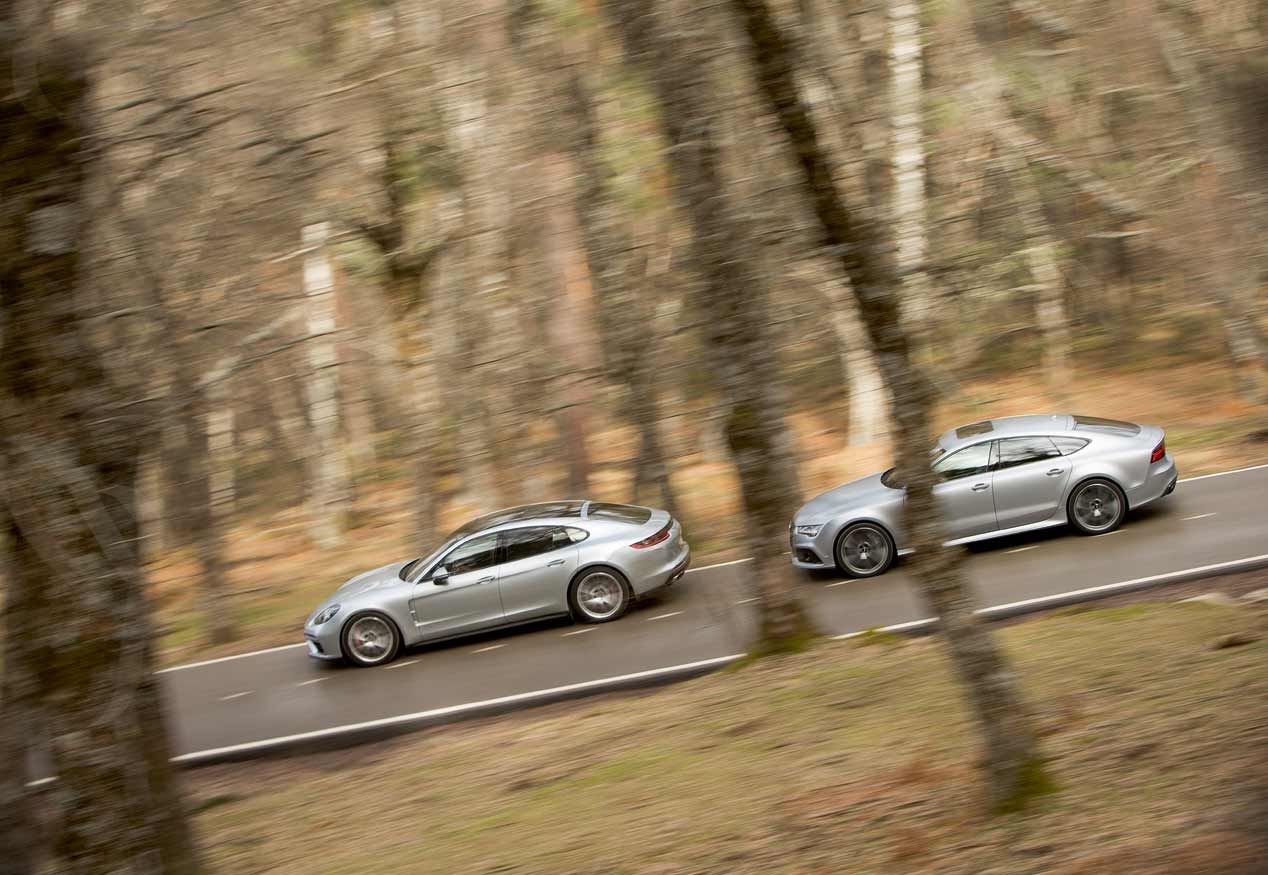 But where yes it has Porsche a “crochet” quadrilateral rival is the rear direction. This is an element that we saw for the first time on the 911 Turbo of the previous generation and is gradually imposing to enhance the dynamic qualities. The truth is that it is a decisive factor in improving athletic performance. Its price is not excessive (2,335 euros) and includes variable direction depending on the speed in the front. This rear direction works at low speeds -up to 50 m / h- wheels spinning in the opposite direction to the front, with a maximum of 2.8 degrees. In all other speeds rotate in the same direction, this makes for more agile slow (as if it had less battle) and more rapid poise (as if it had more battle). All combine in the Porsche with pneumatic adaptive suspension. In this generation the air volume in the chambers 60% higher capacity and hardness variation and response is higher. The reality is that the result is unbeatable. Note the chassis is stiff as a board but without passengers gets them. The pneumatic suspension also provides the known advantages of level control. Along with the normal level they are also available the high level and low level. The high level raises the chassis 20 mm to avoid, for example, the front wing in contact with the ground at the entrances to underground garages. When the low level is active, the height of the front axle is reduced by 28 mm and the rear axle 20 mm to improve performance at high speeds.
But where yes it has Porsche a “crochet” quadrilateral rival is the rear direction. This is an element that we saw for the first time on the 911 Turbo of the previous generation and is gradually imposing to enhance the dynamic qualities. The truth is that it is a decisive factor in improving athletic performance. Its price is not excessive (2,335 euros) and includes variable direction depending on the speed in the front. This rear direction works at low speeds -up to 50 m / h- wheels spinning in the opposite direction to the front, with a maximum of 2.8 degrees. In all other speeds rotate in the same direction, this makes for more agile slow (as if it had less battle) and more rapid poise (as if it had more battle). All combine in the Porsche with pneumatic adaptive suspension. In this generation the air volume in the chambers 60% higher capacity and hardness variation and response is higher. The reality is that the result is unbeatable. Note the chassis is stiff as a board but without passengers gets them. The pneumatic suspension also provides the known advantages of level control. Along with the normal level they are also available the high level and low level. The high level raises the chassis 20 mm to avoid, for example, the front wing in contact with the ground at the entrances to underground garages. When the low level is active, the height of the front axle is reduced by 28 mm and the rear axle 20 mm to improve performance at high speeds.
Faced with this arsenal of punches, the Audi defends the Dynamic Plus package (14,880 euros) It is including the ceramic disc brakes, the dynamic address (alone in front of course, it varies depending steering wheel rotation speed), the extension of maximum speed at 305 km / h, the RS sports suspension plus with DRC (Dynamic Ride Control, which controls the connection between balancing dampers), the selective illumination chamber, sensors and GPS, dynamic cornering light, dynamic turn signals and headlights LED Matrix.
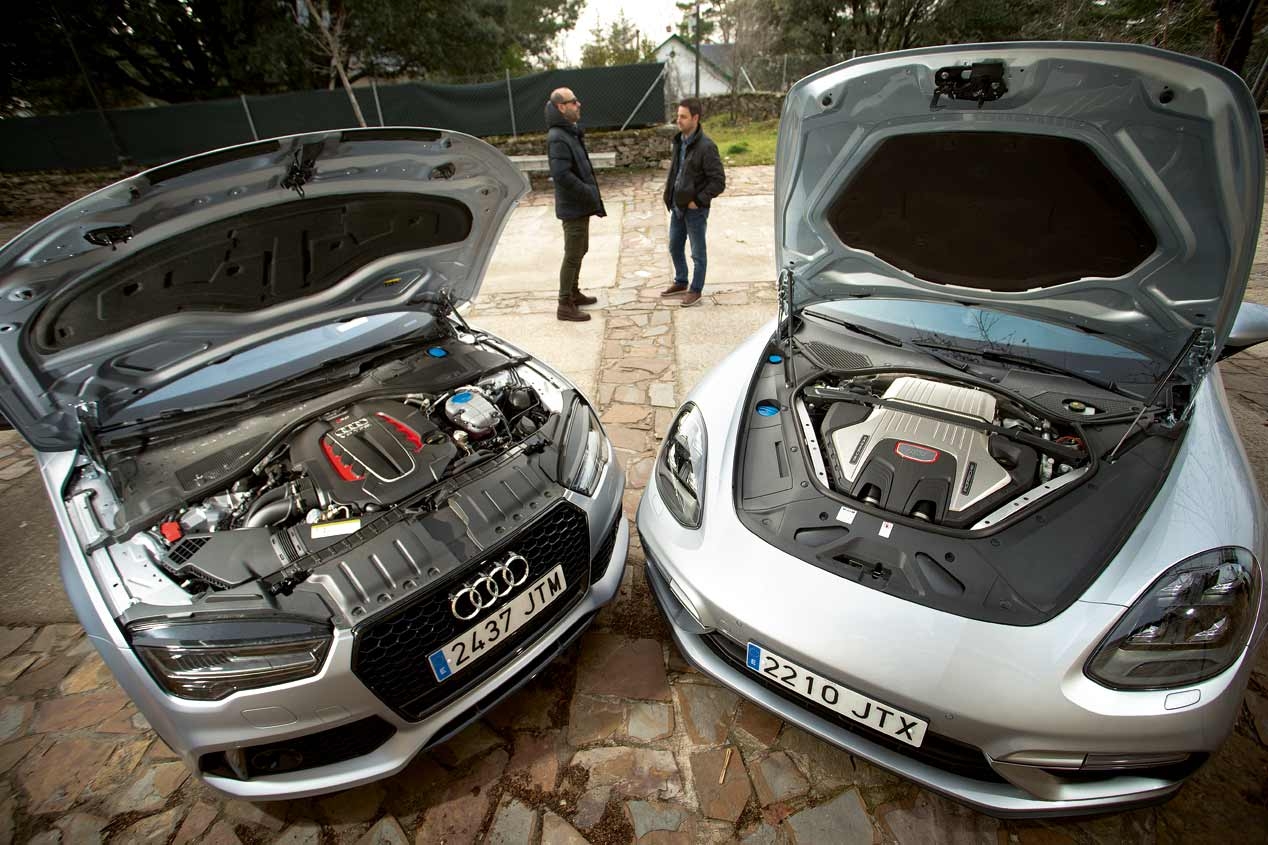 With this option plus the escape, the price of Audi It is equal to that of Porsche that would not need ceramic brakes to balance the scales dynamically speaking. And is that Porsche has stopped us 65 meters from 140 km / h to 0, a miracle for a car of almost 2.1 tons. They also were not exhausted in our test circuit, something that yes happened to RS7 with ceramic brakes. They should not be in very good shape because we ran out of brakes and could not make a good record.
With this option plus the escape, the price of Audi It is equal to that of Porsche that would not need ceramic brakes to balance the scales dynamically speaking. And is that Porsche has stopped us 65 meters from 140 km / h to 0, a miracle for a car of almost 2.1 tons. They also were not exhausted in our test circuit, something that yes happened to RS7 with ceramic brakes. They should not be in very good shape because we ran out of brakes and could not make a good record.
The Porsche performed better in the circuit thanks mainly to the brakes mentioned and the rear direction. However, the latter did not work as well as they would like. I found it very intrusive at times and varied path in slow zones more than necessary. This forced to correct too much and thus lose time. Otherwise the behavior Panamera Turbo It is wonderful with a tendency to oversteer acceleration that makes you remember at all times that you are mounted on a Porsche (Remember that this Panamera, like its rival, is a AWD). The Audi was more predictable in this regard, but with a very understeer character. Not in vain his weight on the front axle is greater than the Porsche. The worst deal less wheel in contact with the asphalt and some exhausted brakes, was the turning hook that dropped him to the canvas in the last assault. And there is a difference of around 1.5 seconds is a long time between two cars that have been kept at bay throughout the fight.
You may also like
– Porsche Panamera 2017 tested the sportiest saloon
– Truck Antonio Albacete vs Audi RS7 Sportback
